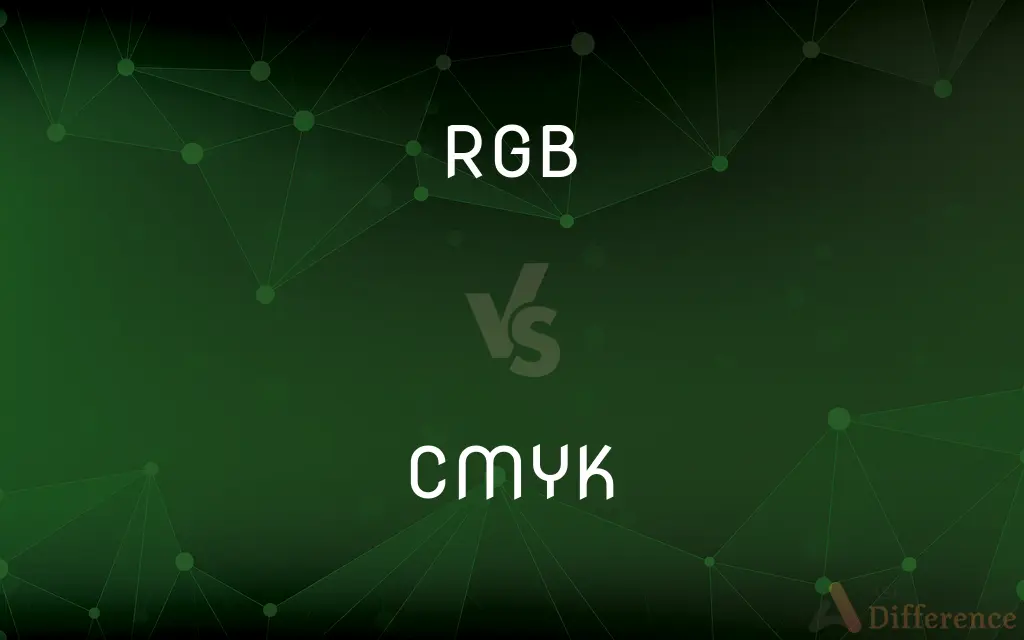RGB vs. CMYK — What's the Difference?
By Tayyaba Rehman — Published on January 8, 2024
RGB is a color model using red, green, and blue light for digital displays. CMYK uses cyan, magenta, yellow, and black inks for printing.

Difference Between RGB and CMYK
Table of Contents
ADVERTISEMENT
Key Differences
RGB (Red, Green, Blue) is a color model primarily used in electronic displays like TVs, computers, and smartphones. It's based on light emission, mixing these three colors at various intensities to produce a wide range of colors. Conversely, CMYK (Cyan, Magenta, Yellow, Key/Black) is a subtractive color model used in color printing. It blends these four ink colors to produce a broad spectrum of colors.
RGB is additive; combining all colors at their highest intensity produces white. In this model, colors are added to black (the absence of light) to create new colors. In contrast, CMYK is subtractive; combining all ink colors in theory results in black, but in practice, it produces a muddy brown, hence the need for the key (black) component.
When designing for digital screens, RGB is used because it offers a wider range of vibrant colors suitable for screens that emit light. However, for printing materials like brochures or magazines, CMYK is the standard because it reflects how inks absorb and reflect light on paper.
RGB colors can appear differently on various devices due to differences in display technology and settings. On the other hand, CMYK provides more consistent color output in the physical print, though it has a smaller color gamut compared to RGB.
In the digital realm, RGB is often used because of its ability to produce bright and varied colors. Conversely, CMYK is essential in printing because it aligns with the color blending process of printers and is vital for accurate color reproduction in print materials.
ADVERTISEMENT
Comparison Chart
Usage
Electronic displays
Color printing
Color Model
Additive (light based)
Subtractive (ink based)
Color Production
Combines light to create colors
Combines inks to create colors
White and Black Creation
All colors at max = White
All colors combined = Black (in theory)
Gamut
Wider color range
Narrower color range
Compare with Definitions
RGB
It uses red, green, and blue light to create colors.
Adjusting RGB values changes the screen color.
CMYK
CMYK provides consistent print output.
CMYK ensures our printed colors match the design.
RGB
Ideal for digital mediums that emit light.
Smartphones use RGB for their colorful displays.
CMYK
Essential for accurate color reproduction in print.
Our brochures are printed with precise CMYK colors.
RGB
RGB colors can vary across different devices.
The same RGB color can look different on various screens.
CMYK
CMYK is a color model for printing.
We use CMYK for our magazine prints.
RGB
RGB combines colors additively.
RGB creates white by combining all colors at full intensity.
CMYK
It combines cyan, magenta, yellow, and black inks.
The CMYK values determine the ink mix for printing.
RGB
RGB is a color model for electronic displays.
My monitor uses the RGB model for vivid colors.
CMYK
CMYK is a subtractive color model.
CMYK subtracts brightness from white paper to create colors.
Common Curiosities
When should I use RGB?
Use RGB for anything displayed on digital screens, like websites and videos.
When is CMYK preferred?
CMYK is preferred for printed materials like brochures and business cards.
What does RGB stand for?
RGB stands for Red, Green, and Blue.
Are RGB colors consistent across devices?
No, RGB colors can vary due to different display technologies and settings.
What does CMYK stand for?
CMYK stands for Cyan, Magenta, Yellow, and Key (Black).
Can I use CMYK for web design?
No, web design should be done in RGB for accurate color display on screens.
Can RGB display more colors than CMYK?
Yes, RGB has a wider color gamut and can display more vibrant colors.
Why can't I use RGB for printing?
RGB is designed for light-based displays and does not translate well to ink-based printing.
How do RGB and CMYK affect design?
Designers must consider the final medium (screen or print) to choose the right color model.
Can I convert RGB to CMYK?
Yes, but the conversion may alter some colors due to the different gamuts.
Do printers print RGB directly?
Most standard printers are calibrated for CMYK, not RGB.
Why do printed colors sometimes look different from the screen?
This is due to the difference between light-based RGB colors on screens and ink-based CMYK colors in print.
Does CMYK cover the same range of colors as RGB?
No, CMYK has a narrower color range compared to RGB.
Why does black in CMYK look different than in RGB?
In RGB, black is the absence of light, while in CMYK, it's a combination of inks.
Is CMYK suitable for digital artwork?
No, CMYK is best for print work; digital artwork is better in RGB.
Share Your Discovery

Previous Comparison
Pros vs. Cons
Next Comparison
Applet in Java vs. Servlet in JavaAuthor Spotlight
Written by
Tayyaba RehmanTayyaba Rehman is a distinguished writer, currently serving as a primary contributor to askdifference.com. As a researcher in semantics and etymology, Tayyaba's passion for the complexity of languages and their distinctions has found a perfect home on the platform. Tayyaba delves into the intricacies of language, distinguishing between commonly confused words and phrases, thereby providing clarity for readers worldwide.











































